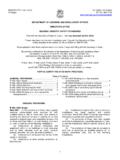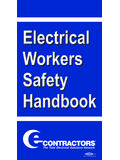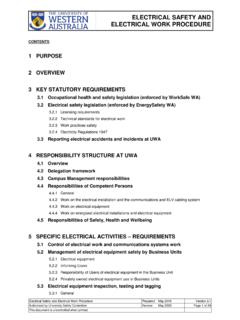Transcription of Common Safety Practices for On-Farm Anaerobic …
1 Safety Practices for On-Farm Anaerobic digestion Systems TABLE OF CONTENTS INTRODUCTION .. 1 Safety HAZARDS FOR Anaerobic digestion .. 1 GENERAL Safety PRECAUTIONS .. 2 Drowning .. 2 Fall protection .. 2 Burns .. 3 Entanglement hazard .. 3 Feedstock and digestate spills .. 4 Mechanical failures .. 4 Lockout/Tagout .. 5 Ignition sources .. 5 Noise levels .. 6 CONFINED SPACE ENTRY .. 7 Definition .. 8 Confined space training, certification, and rescue plan .. 8 Inspect atmosphere prior to entry .. 9 Safety 9 HAZARDS ASSOCIATED WITH BIOGAS .. 10 Asphyxiants .. 10 Immediately dangerous to life and health .. 11 Explosion potential .. 11 ELECTRICAL system HAZARDS.
2 12 High voltage .. 12 Low voltage .. 12 Electrical fires .. 13 Safety Practices for On-Farm Anaerobic digestion Systems MAINTAINING A SAFE WORKING ENVIRONMENT .. 13 EMERGENCY ACTION PLAN .. 13 Directions to AD facility .. 14 Contact information .. 14 Site map .. 15 State and local health and Safety requirements .. 15 Equipment vendor manuals .. 15 Safety AND EMERGENCY EQUIPMENT .. 15 Anaerobic digester facility (onsite) .. 15 Locally (able to be onsite within a few hours) .. 16 Baseline environmental conditions .. 16 ELECTRICAL .. 17 Daily inspections .. 17 Switches, controllers, fuses, and breaker panels .. 17 Roles of operators .. 18 Visitors on site.
3 18 PERSONAL PROTECTIVE EQUIPMENT .. 18 ACCIDENT PREVENTION SIGNS AND TAGS .. 18 PERSONNEL TRAINING REQUIREMENTS .. 19 CONCLUSION .. 19 REFERENCES .. 20 Safety Practices for On-Farm Anaerobic digestion Systems 1 INTRODUCTION Several Safety hazards exist when converting manure and organic residuals (non- farm feedstock) into energy using Anaerobic digestion (AD) technology. These hazards can cause serious bodily harm and in some circumstances, can be fatal. Common hazards Figure 1: Safety signage on AD feed system associated with AD systems include drowning, electric shock, and noise exposure. However, biogas and its constituents, many of which are colorless and odorless, can unknowingly expose operators and visitors to hazards such as asphyxiation and burns due the flammable nature of methane.
4 Workers must take proper precautions when handling and storing organic material and managing the production of electricity and combustible gases. The purpose of this document is to identify the major hazards associated with an AD facility and outline basic Practices that will help maintain a safe and successful working environment. The intended audience for this guide is owners and operators, and the guide is not intended to replace Safety training or instruction, but rather enhance it. Safety HAZARDS FOR Anaerobic digestion The following sections identify major hazards that can exist with an AD facility. These include: General Safety precautions Hazards associated with biogas Confined space entry Electrical system hazards Figure 1 shows a feed hopper for an Anaerobic digester with a dozen warning signs, including fall, entanglement, and explosion potential.
5 Safety Practices for On-Farm Anaerobic digestion Systems 2 GENERAL Safety PRECAUTIONS The following sections describe general Safety concerns associated with AD facilities. Drowning Liquid tanks and ponds for storage pose a drowning threat. Whenever a drowning potential exists, ring buoys, ropes, or ladders should be readily available for rescue purposes (Occupational Safety and Health Administration [OSHA], 2002). The drowning risk is highest when employees are servicing equipment located in digester or storage tanks. Accidental drowning can occur when people unfamiliar with the farm and manure handling system mistakenly enter storage structures. Slipping on a synthetic liner or walking on crusted manure storage are examples of situations that can lead to accidental drowning.
6 OSHA suggests posting signs similar to the one shown in Figure 2 and erecting fences around manure storage structures to reduce the potential of an individual or animal unknowingly entering one. If an individual is drowning, the first step should be to call 911, followed by a rescue attempt using a life preserver, rope, or ladder. The presence of biogas an asphyxiant that can cause a person to pass out can increase the potential of manure storage drowning. (Biogas hazards are discussed in greater detail in Section ) Individuals attempting to rescue a drowning individual should never enter a manure storage structure because they could also be overcome by the poor air quality. Fall protection Serious injuries can result from falls of any distance.
7 When possible, employees should perform maintenance work from the ground. At most AD facilities, however, multiple elevated locations are present. For example, equipment on the top of aboveground AD tanks are 10 to 25 feet off the ground. According to the OSHA general industry standard any time a worker is at a height of four feet or more, the worker is at risk and needs to be protected (OSHA, 2008A). Fall protection, such as guardrails, a Safety harness (also discussed in Section ), and self-retracting lifelines, should be used when an employee is above the 4-foot threshold (API, 2006). The enclosed fixed ladder and guardrail system on the feedstock storage tank shown in Figure 3 complies with OSHA fall protection standards.
8 Figure 2: Manure storage warning sign in English and Spanish Safety Practices for On-Farm Anaerobic digestion Systems 3 Another Common example of a fall risk is shown in Figure 4, where a ladder is leaned against a feedstock , Figure 3: Permanent ladder and guardrail on feedstock storage tank storage tank. The two concerns with the situation presented in Figure 4 are: (1) the tank height is approximately 10 feet and (2) there are no securing devices or slip resistant feet on the ladder, nor is there a rope to secure the top. When ladders are used to access elevated equipment, they should be secured and supervised at all times. Once the ladder is no longer needed, it should be removed. Burns Throughout an AD facility, pipes containing hot fluids or exhaust gas can pose potential burn hazards.
9 Other potential sources of burns are heat exchangersboilers, pumps, or engine generators, where temperatures can exceed 160oF. Simply rubbing up against a heat exchanger or accidently placing a handon a hot pipe can result in serious burns. All employees and visitors to the AD facility should be cautioned not to touch any equipment or pipelines. When possible, hot surfaces should be identified as burn hazards, and all pipes should be clearly labeled to indicate the contents, flow direction, temperature, and pressure. Insulation should be used to encase the pipe and reduce the potential for accidental burns. Figures 5 and 6 provide examples of pipeline insulation and labeling. Entanglement hazard Pumps, augers, impeller mixers, chains, drive shafts, and other machinery pose entanglement hazards due to pinch points and other moving parts.
10 In most AD systems, the primary exposure to entanglement is the unguarded driveshaft Figure 4: Ladder leaning on feedstock storage tank Safety Practices for On-Farm Anaerobic digestion Systems 4 of a pump. To reduce the entanglement risk, all equipment Safety guards should be in place and individuals should tie back long hair and avoid wearing loose-fitting clothing and jewelry. Feedstock and digestate spills Feedstock (any organic material entering the digester) and digestate (any material exiting the digester) should be carefully transferred and contained. In the event of a major feedstock or digestate spill, workers should exercise caution when containing the material. The first step should be to control the source causing the spill.
















